ASUS ROG Strix Scar 16 review: next-gen gaming unleashed | 91mobiles.com
Taiwanese electronics giant ASUS has unveiled its latest additions to its iconic ROG lineup. One of them is the ROG Strix Scar 16, which can be considered a significant upgrade over last year’s models and it is priced keeping that in mind as well. Starting at Rs 2,79,990, the latest ROG offering is apt mainly for users with deep pockets. However, there’s a good reason the Strix Scar 16 takes such a massive bite out of your wallet. Looking at the specs on paper, the device is likely one of the most powerful laptops in the world right now. ASUS has seldom left me disappointed with its top-of-the-line offerings and I have no reason to believe otherwise with the Scar 16. Let’s find out in this full review just how capable this gaming machine is.
Build, design, and ports
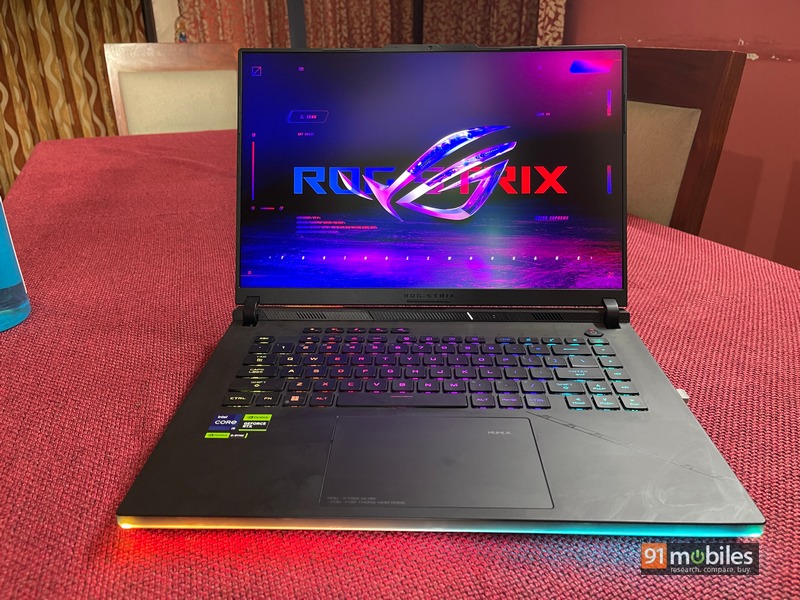
As far as the exterior is concerned, the Scar 16 takes its cues from its last iteration. This includes the strip of ROG branding that partitions the sleek-looking lid. A replication of this design choice is also seen on the inside along the keyboard. However, one side gets a translucent finish, allowing an obfuscated peak of the motherboard. Like its predecessor, it does impart a very unique look to the laptop in a segment where outlandish appearance is a key selling point. While the lid has a metallic build to it, the base is made using matte-finish plastic. There’s just one single colour option to choose from but that suits me just fine as the deep grey scheme goes well with the laptop’s RGB light show. You are greeted with the Auro Glow lighting strip at the bottom, and at the back as well, not to mention the ROG logo is lit up like a Christmas tree as well.
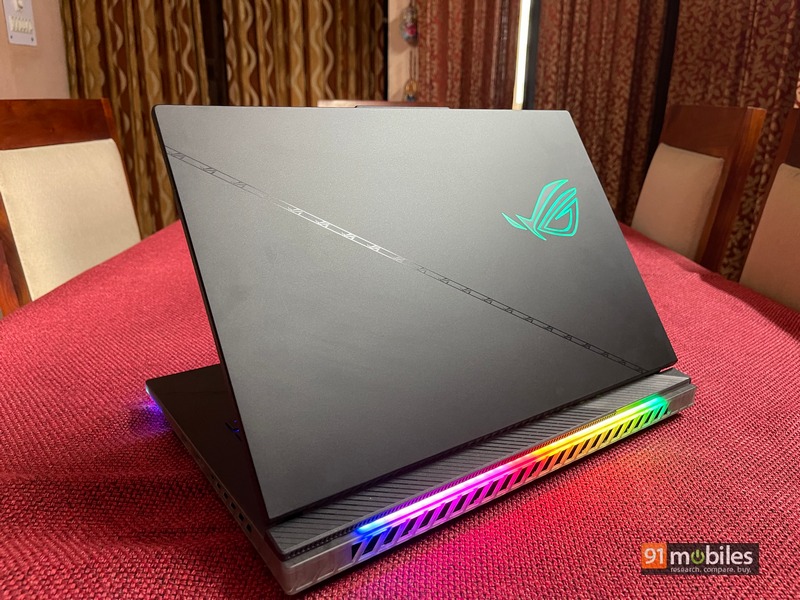
Construction-wise, the Scar 16 is as rigid and sturdy as they come. Of course, the meaty internals leaves little room for portability with the device weighing nearly 2.5kg. If you were to take it outside, you would also have to make room for the abnormally large 330W charging brick. In short, if you are keen on buying this machine, best keep it on your desk and leave it there. The hinge design has me reasonably impressed, with the lid opening easily with just one finger. Even so, the display can only tilt to about 135 degrees which I found to be slightly restrictive. Replaceable armour caps, a feature from last year’s Scar series, have been ported over to this current generation. They snap in place magnetically, just below the lid, and can be customised as well according to your preference. Thermal outlets are present on three sides with the most prominent being on the back, near the heat sink. Finally, we also get the long overdue addition of a webcam and it is placed just above the display.
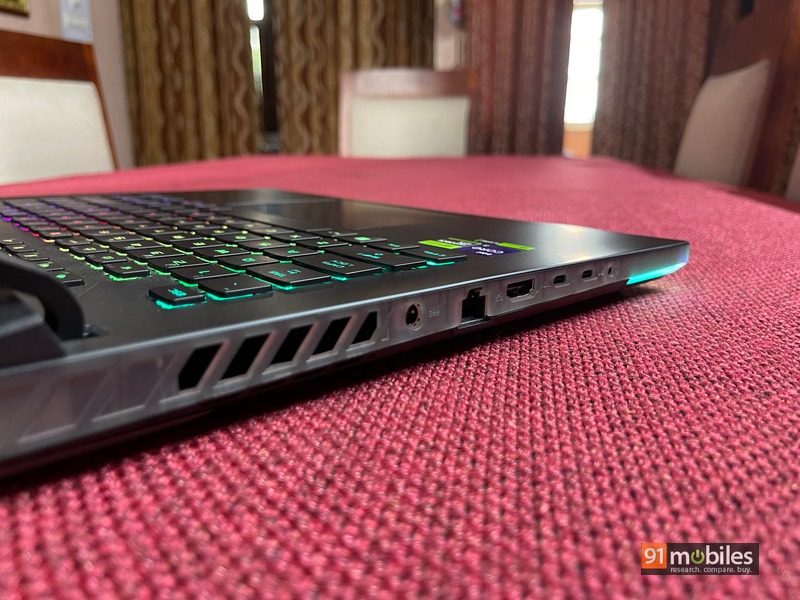
Coming now to the ports on the device and you can see there have been some upgrades here as well. There are two USB 3.2 Type-A Gen2 ports, up from the Gen1 slots last year. The USB Type-C 3.2 port remains the same and it has both DisplayPort and power delivery capabilities. However, the second Type-C port, with Thunderbolt 4, can support another display with G-sync. Apart from that you get an assortment of HDMI 2.1, 2.5G LAN RJ-45, and a 3.5mm headphone jack. In terms of wireless options, the laptop has Wi-Fi 6E (triple-band) support alongside Bluetooth 5.2 connectivity. I would’ve preferred the addition of a microSD or an SD card reader, just for more versatility. Also, there are no biometric options for unlocking the laptop.
Also Read: ASUS ROG Strix Scar 17 SE review: performance for the ages
Display
Big upgrades have been made to the Strix Scar 16’s display with the most prominent being a mini-LED panel being used to replace the LCD screen from last year. While not in the same league as a true OLED offering, the Scar 16 can be considered more than optimum for gaming and viewing. Branded as the Nebula HDR display, the laptop packs in 1,024 local dimming zones, which is not best in class, but the screen does a fairly decent job of amplifying the blacks. Apart from that the display also gets very bright at up to 1,100nits when HDR content is being played. The gaming experience is handled by the 240Hz refresh rate on offer and up to 3ms response time, both of
which are definitely best-in-class. Support for G-sync is also a part of this to help reduce frame tearing and provide smoother gameplay.
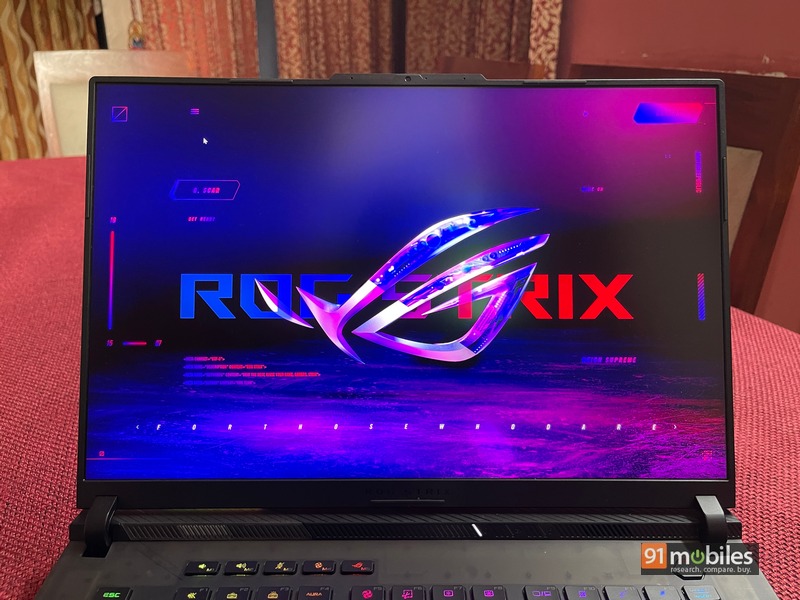
Talking about the colour reproduction itself, the Scar 16’s display leaves very few stones unturned in its quest to provide an immersive experience. Apart from being certified for Dolby Vision, the screen also has Pantone validation and support for 100 percent of the DCI-P3 colour gamut. An anti-glare coating is present on the display but it does not mute the colours one bit and instead makes it very easy to view content even with a bright light shining behind me. The 16:10 screen can output QHD (2,560 x 1,600) resolution. From my time playing graphics-heavy AAA titles to viewing HDR content, the ASUS Strix Scar 16 has been a tremendous joy. The local dimming zones activate immaculately for deep blacks that go well with the contrasty nature of the panel. Even so, the device is not highly suitable for any colour correction or creative work.
Keyboard and trackpad
ASUS’ keyboard game has almost always been of the top drawer and I’m happy to report that this has not wavered one bit with the Scar 16. The rubber-dome switch implementation, prevalent over the past few generations on ROG, works well in terms of input and tactile feel. The keys are spaced out thanks to the wide chassis along with no numpad on the side. There are a couple of hotkeys up top such as volume control, fan speed, and ASUS’ Armory crate launcher.
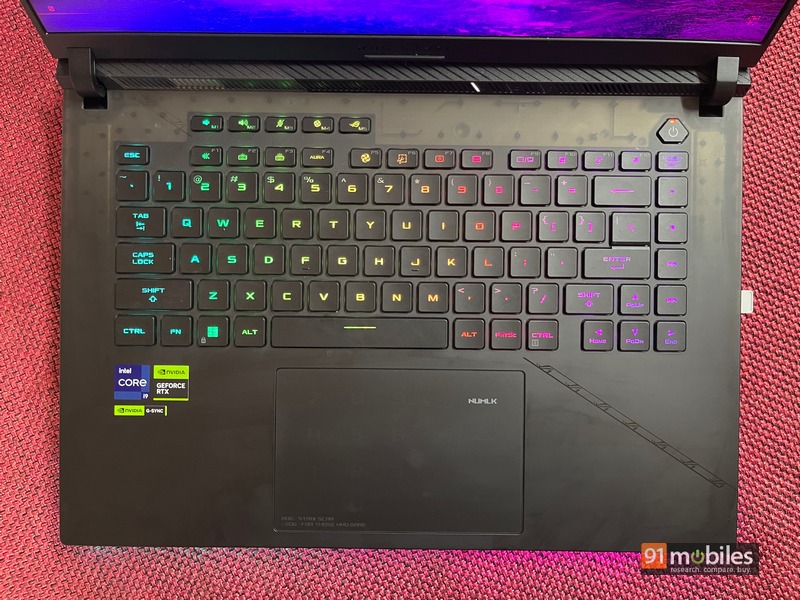
Per-key RGB customisation is available in the app and you can adjust the backlighting to three levels. I appreciate the fact that the arrow keys are full-size although I would’ve liked the right Shift key to be slightly longer. What I do like quite a lot is the little air inlets on the WASD keys which keep my fingers cool even though the surrounding area becomes warm. The overall typing feel on the keyboard is refined and to my liking with travel on each key slightly shallow at 2mm.
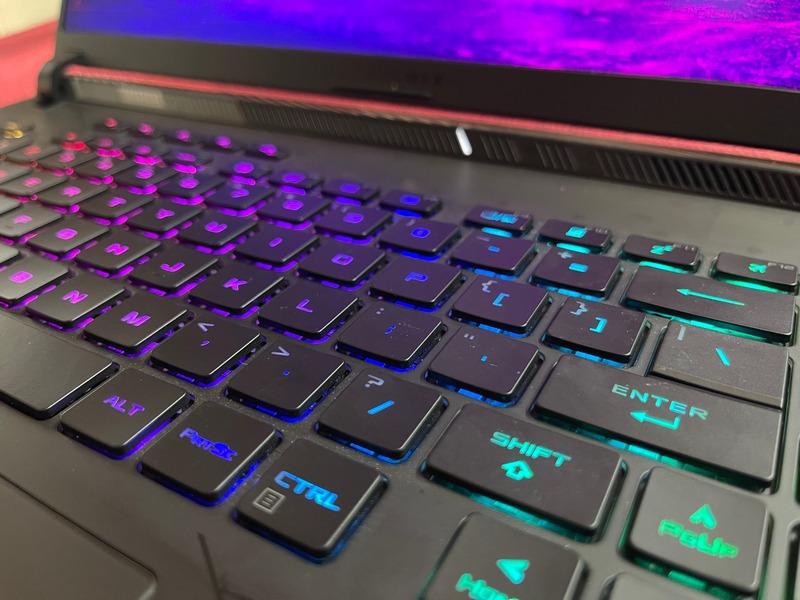
As for the trackpad, it has a substantial surface area and also comes with a glass coating. My finger glides over it quite effortlessly while the response rate is quite good as well. The trackpad also doubles up as a virtual numpad with large sections outlined for each number and symbol. Personally, I feel that this is more of a gimmick and not very useful, but you might feel differently. Apart from that, the gesture controls work relatively well although not as smoothly as you see on a mac. Finally, my thoughts are that investing in a proper gaming mouse would be worthwhile if your intentions are not just to browse the internet on the machine.
Performance, software and audio
Under the hood, the Scar 16 employs Intel’s i9 13980HX processor, currently one of the most powerful pieces of silicone in the PC world. This 24-core CPU has eight performance cores and 16 efficiency cores with a max turbo frequency of 5.6GHz. In terms of TDP, the chipset draws upwards of 150W at Turbo mode, which entails excellent performance when demanded. I won’t go too much into normal benchmarking numbers as the Scar 16 blows last year’s competition completely out of the water. Cinebench R23 multi-core score of 30,065 is the highest I’ve seen till now on any laptop. You can expect any normal tasks, such as casual Chrome browsing or Microsoft Office or just about any app to run smoothly. PCMark 10’s score of 9,137 surmises that point up quite aptly.
In terms of storage, the variant I have comes with 32GB dual-channel DDR5-4800 RAM and 1TB PCIe Gen 4 SSD. If you want more, the laptop can have up to 64GB in RAM and has two slots for PCIe G4 slots arranged in a RAID 0 configuration for up to 4TB storage. I did run the CrystalDiskMark test for SSD speeds and got about 6,993MB/s and 5,132MB/s as read and write speeds respectively. For the uninitiated, these kinds of SSD performances are basically overkill and would not be necessary for typical gaming needs. However, if you are transferring large video projects within the system, the process becomes lightning-fast thanks to SSDs configuration.
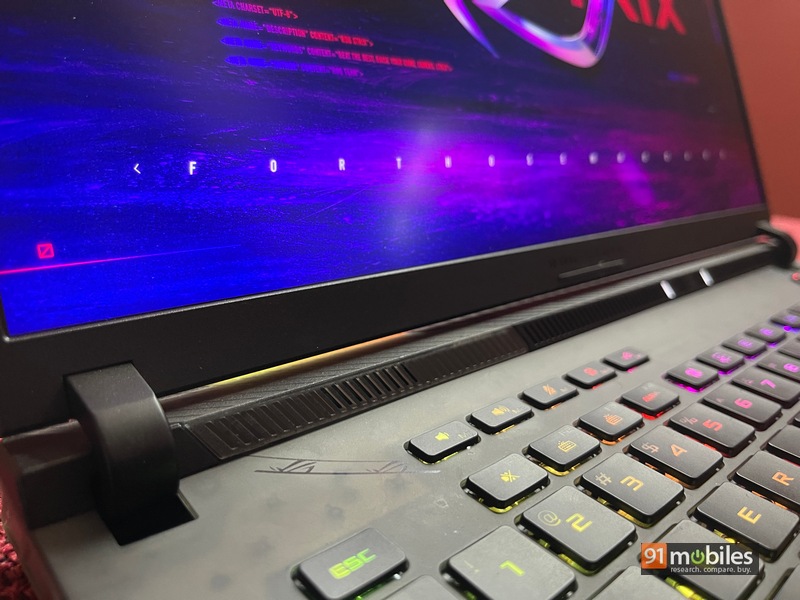
Right then, the GPU. NVIDIA’s RTX 4080 handles the bulk of the graphical tasks thrown at the Strix Scar 16. With Dynamic Boost enabled, the GPU can draw upwards of 175W, which is a 25W jump from last year’s model. At Manual mode, the total crossload with the CPU and discreet GPU can go up to 240W, and that in turn can generate a lot of heat. However, the thermal capabilities of the device take care of any concerns that may arise. As mentioned earlier, the heatsink in place measures the full width of the laptop which helps in more heat dissipation. There’s also a third fan, alongside the two big ones, which is specifically placed to cool the GPU. Apart from that you have seven heat pipes leading away from the CPU and the Conductonaut Extreme liquid metal being used instead of a regular thermal paste. In short, the Scar 16’s heat dissipation setup is extremely robust and creates an enjoyable gaming experience.
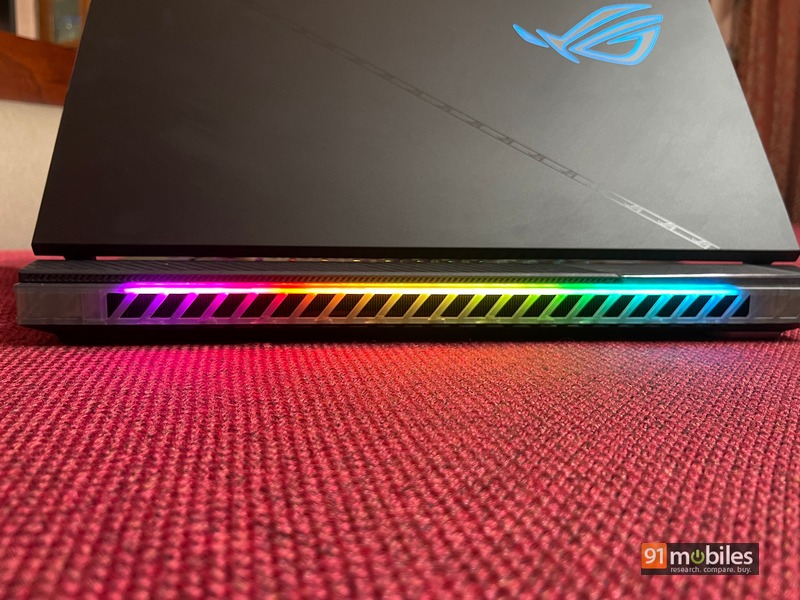
With the RTX 4080, paired with 8GB of DDR6 VRAM, even a demanding AAA title will run full tilt without even a hint of a lag. Here are some fps counts on popular games but there are a couple of things to note here. The resolution is set at 2K, ray-tracing is maxed out, DLSS is on and graphics are set to the highest possible settings. Shadow of the Tomb Raider benchmarked at an average frame rate of 134fps. CyberPunk 2077 did 104fps although the in-game count fluctuated between 95-105fps depending on how much textures had to be rendered. Witcher 3 did between 90-100fps while God Of War settled nicely between 100-110fps. Some of the less intensive titles like CS:GO can easily shoot past 350fps while Call of Duty: Warzone also hovered around the 200fps mark. These are just highly impressive numbers and what I really loved is how well the fps count was maintained even after a very long gaming session. The MUX switch, which bypasses the CPU and connects the display directly to the GPU, is one of the many reasons why the Scar 16 is a formidable gaming behemoth.
Out of the box, the laptop comes loaded with Windows 11, which can be expected on laptops nowadays. The real cherry on top is the Armoury Crate app which lets you fine-tune your usage down to the tiny details. It is here that you are always aware of your CPU and GPU temps, fan speeds, GPU modes to be enabled and a lot more. Performance profile can also be selected here and customised to your liking along with changing the display response time. Finally, the plethora of RBG lighting across the chassis and on the keyboard can also be altered within the app. The device has a quad-speaker setup for audio but I wouldn’t count on it being any good while gaming. Also, the 720p webcam, while being a nice addition, is passable at best and should be limited to only video-conferencing calls.
Battery
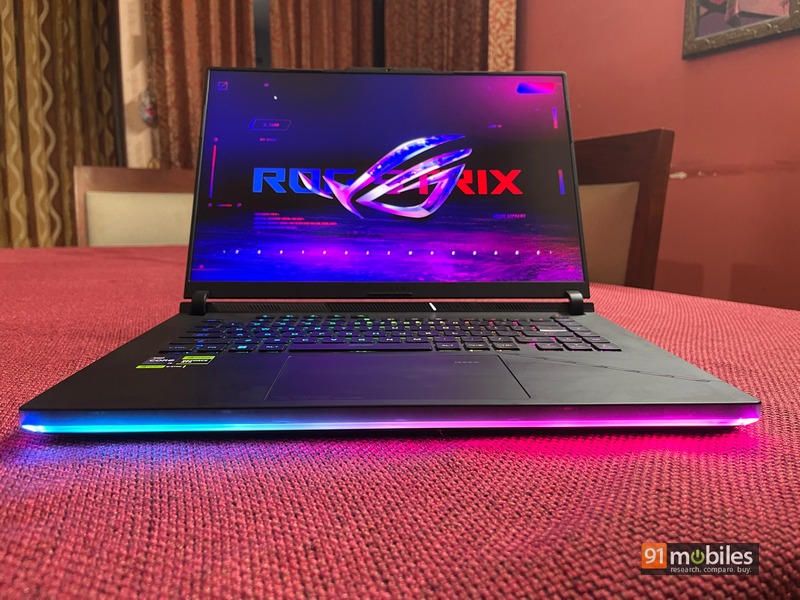
There’s a 90Whr battery present on the laptop but it would not be of much use without the 330W charging brick provided with the box. By default, the laptop cuts down most of its processing power when unplugged but even with that, you would be hard-pressed to get even four hours of screen-on time with the Scar 16. The device is meant to be operated with its AC adapter and not doing so is just going to downgrade your experience.
Verdict
There will obviously be more RTX 4000 series laptops paired with the 13th-gen Intel processors. All of them will undoubtedly be quite good in the performance department and will, more than likely, cost a pretty penny. However, ASUS has a history of making remarkably high-octane laptops that do nothing to disturb a fluid gaming experience. The ROG Strix Scar 16 has all the ingredients for the highest quality in GPU and processor-intensive tasks. It also has a remarkable display to back it up and a string of software and hardware tricks to maintain its gamer aesthetic.
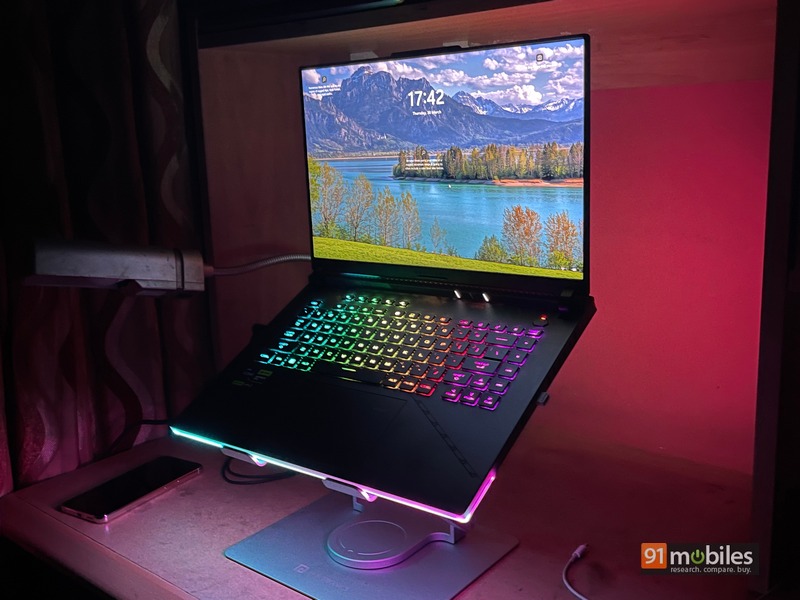
Apart from a missed SD card slot and rather average speakers, the laptop doesn’t appear to miss a beat at all. I guess what I’m saying is that 2023 will reveal many more capable machines but I doubt any will quite match up to the overall package that is the ASUS ROG Strix Scar 16. Ultimately though, for those seeking a top-of-the-line gaming laptop this year, the ROG Strix Scar 16 is certainly a strong contender that shouldn’t be overlooked.
Editor’s rating: 4 / 5
Pros:
- Supreme performance
- Excellent display for gaming
- Solid gamer aesthetic
- Effective thermal management
Cons:
- Could use an SD card slot
- 720p webcam
- Sup-par speakers
For all the latest Technology News Click Here
For the latest news and updates, follow us on Google News.

